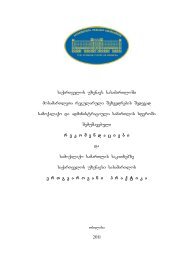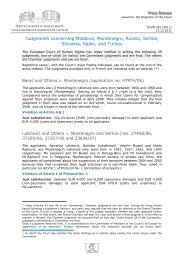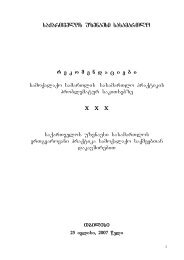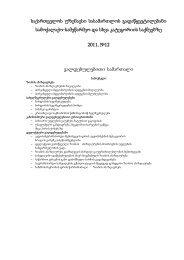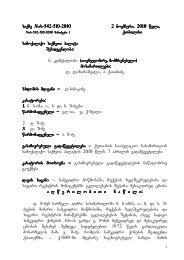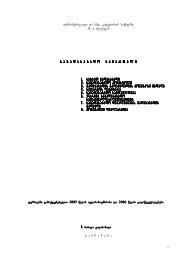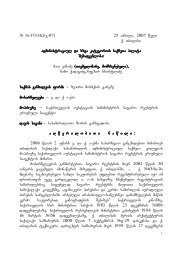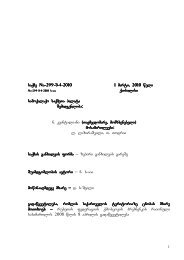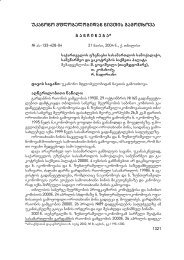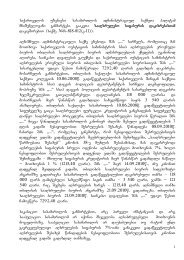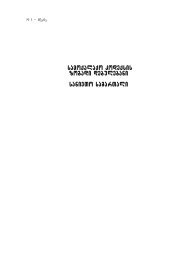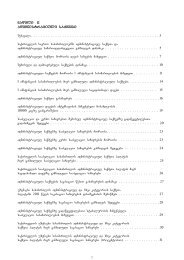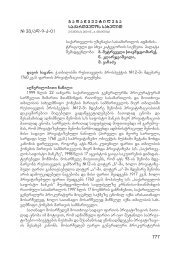marTlmsajuleba kanoni
marTlmsajuleba kanoni
marTlmsajuleba kanoni
You also want an ePaper? Increase the reach of your titles
YUMPU automatically turns print PDFs into web optimized ePapers that Google loves.
FOOTNOTES<br />
1<br />
Advanced legal systems leave preparation of a crime unpunished (Jean Pradel, Comparative<br />
Criminal Law” (Edition Dalloz, 1995). P. 242. However, there are exceptions from this<br />
rule. Conspiracy to commit crime is punishable in UK, US, France as separate crime.<br />
Preparation of particularly serious crime is punishable in Spain, Netherlands and some<br />
other countries.<br />
2<br />
(1915) 2. K.B. 342, in this case, the court used a proximity test. (see below). A similar case<br />
was attributed also to the ambit of preparatory activity by the Supreme Court in Germany<br />
(BGH Dallinger MDR 1966, 197).<br />
3<br />
Comer v. Bloomfield (1970) (55) Cr. App. Rep. 305. The court applied proximity test. A<br />
similar case, which happened in France was also attributed to the preparation by French<br />
court (Crim. 22 Mai, 1984.)<br />
4<br />
R. v. Rowley (1992) Cr. App. R. 95<br />
5<br />
R. v. Rowley (1992) Cr. App. R. 95<br />
6<br />
R. v. Jones (1990) 91. Cr. App. R. 351<br />
7<br />
R. v. White 1910 2. K. B. . In this case the court applied first act test according to which<br />
it is enough for defendant to commit first act from a series of acts directed to commission<br />
of the crime.<br />
8<br />
Commonwealth v. Peaslee (177 Mass) 277 . In this case the court used proximity test<br />
9<br />
Chambre Criminelle, 13 Janvier, 1913, D. 1914. Similarly was held to the act of waiting<br />
at the place where the car transporting the money should have passed. place where the<br />
money with<br />
10<br />
People v. Rizzo 246. N.Y. The court used proximity test.<br />
11<br />
Crim 11 Juin, 1975<br />
12<br />
Crim. 14 Juin, 1995<br />
13<br />
Crim. 5 Juin, 1984<br />
14<br />
“The attempt is characterized by actions which should immediately be followed by<br />
completed crime (Crim. 25 oct. 1962)<br />
15<br />
Tosti (1997) Criminal Law Review 476<br />
16<br />
BGH 22, 80<br />
17<br />
Similar formula is applied by criminal codes of some other European countries such as<br />
Netherlands, Belgium, Switzerland.<br />
18<br />
Rex. V. Barker (1924) This theory was applied by English and American courts but was<br />
finally rejected. In Our view this theory extends the borders of punishable attempt and<br />
covers also very preparatory actions as well as revelation of intent.<br />
19<br />
This theory is often applied by English and American courts. Also High Court of<br />
Belgium.- Jean Pradel “Droit pénal général comparé” (edition cujas, 2005) p. 76<br />
20<br />
This test was first applied in Regina v. Egleton (London 1855), It is often criticized<br />
because excessively limits borders of punishable attempt. Unless the suspected murderer<br />
pulls the trigger, he may not be made responsible for the attempt..<br />
21<br />
In French criminal law, this theory is supported by authors Ortolan and VIley. Michele<br />
Laure Rassat – DDroit Penal General (2004) p. 312<br />
22<br />
Such countries are UK and some US states.<br />
25



